Last year I wrote a blog entry about my online History course, and about my efforts to bring “reality” into my classroom. I described trying to make my course relevant to 16 year olds, went over some of the projects and portfolios of work we put together, and finally reflected on the ways current world events peeked their way into the program. Though the year ended on a high note, and the experience was rewarding, it wasn’t quite enough. I think I was searching for something more “meaningful” in terms of what we were doing and making but I really didn’t know quite what that signified.
This year, back in my consultant’s role at LEARN, various articles related to a more constructivist approach to education passed through my mailing lists and caught my eye. Most though read like this one, “Ensuring Meaningful Classroom Activities” at http://www.plsweb.com/Products-Resources/Newsletter/Newsletter-Archives/March-2008: that is to say, they focussed on the importance of making activities “engaging” to students; they talked about how students learn better when working “actively” on projects that require questioning and problem-solving; and in the end they found relevance mostly in teaching and “practicing” the kind of 21st century skills our students would most likely need in their future. (See http://www.p21.org/overview/skills-framework to remember these include technological skills, but also collaboration, creativity and critical thinking.) These type of articles are all well and good, but I couldn’t help thinking that what they were describing was still a process contained in a fake, safe, laboratory classroom environment, where students work through “scenarios” that imitate life but aren’t actually involved in the real-world.
Reflecting on why this bothers me at all, I often fall back to an inspiring lecture by Alan November. In “Myths and Opportunities: Technology in the Classroom” http://vimeo.com/3930740 November talks of his home town of Marblehead, Massachusetts’ and its 17th century global vision. He describes how back then they used their “technologies” to trade, make money, and work “with the world.” And above all else, he is impressed and fascinated by an environment where youth 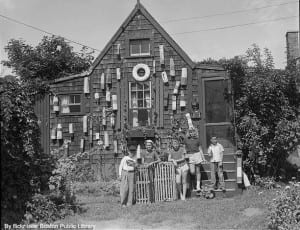 not only knew about the world, but where they contributed to the community’s function within that world. Kids at 10 went out to sea, they became apprentices, they worked in the port, and in doing so they really used the technology of the times. Sadly, for November, technology today (and education today!) prevents students from actually working, and thus they don’t have a sense of what it means to really make a contribution. I was drawn to one line in particular: To fix this we need to “change the concept of learner to someone who becomes a contributor doing their work.” [My emphasis] And, he goes on to say, “that means we also have to redefine the work!”
not only knew about the world, but where they contributed to the community’s function within that world. Kids at 10 went out to sea, they became apprentices, they worked in the port, and in doing so they really used the technology of the times. Sadly, for November, technology today (and education today!) prevents students from actually working, and thus they don’t have a sense of what it means to really make a contribution. I was drawn to one line in particular: To fix this we need to “change the concept of learner to someone who becomes a contributor doing their work.” [My emphasis] And, he goes on to say, “that means we also have to redefine the work!”
The video is really worth watching to the end. It eventually focusses on that redefinition of work, talks of “shifting control” from teacher at centre to a network of children and learners. He talks of allowing students to get involved in “conversations,” and of letting them out to connect with the rest of the world. November sees that as a way to better engage students, where teachers need to first give students a say, then they need to ease off on their “constraint of filtering” information, allowing students to use the social tools available to all of us. He suggests letting students practice jobs in class like “global communicator, global researcher, tool builder, internal collaborator, etc.” and reminds us that these are skills that are essential in the workplace. It is a compelling and even radical challenge to teachers, but again, for me, his talk ended by not going far enough, by falling back on a process of modelling and of practicing skills. Again, I pictured students in a closed and protected building, working in a laboratory, while outside the world happens all around them.
So what would be really different from that picture? What could immediately break those walls? Well, the first thing that comes to my mind is related to the most popular of current technologies. Computers? Well in part. 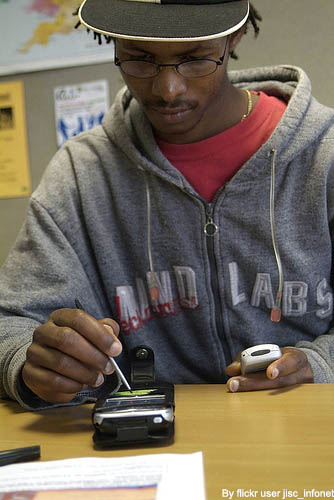 But that’s not what students use daily, that’s not what people use most in their workplace. Fact: In most student’s pockets a cell phone lingers that they could use to call the world. In around a fifth of those pockets (easily enough to be used with other in groups), student already have “smart” devices that can pull up more information than the entire Library of Congress in a single click. With these devices they could… explore an issue, record information, investigate perspectives, formulate a hypothesis and propose a solutions. Sound familiar? Actually, here’s what the real world looks like too (based on http://www.youtube.com/watch?v=LMCZvGesRz8): An analyst needs to find a production solution for a company, she researches on her device, she contacts focus groups on her device, they gather data and share on their devices, they use their devices to project information. Key words: HER DEVICE, THEIR DEVICE, and REAL-WORLD.
But that’s not what students use daily, that’s not what people use most in their workplace. Fact: In most student’s pockets a cell phone lingers that they could use to call the world. In around a fifth of those pockets (easily enough to be used with other in groups), student already have “smart” devices that can pull up more information than the entire Library of Congress in a single click. With these devices they could… explore an issue, record information, investigate perspectives, formulate a hypothesis and propose a solutions. Sound familiar? Actually, here’s what the real world looks like too (based on http://www.youtube.com/watch?v=LMCZvGesRz8): An analyst needs to find a production solution for a company, she researches on her device, she contacts focus groups on her device, they gather data and share on their devices, they use their devices to project information. Key words: HER DEVICE, THEIR DEVICE, and REAL-WORLD.
Unfortunately, whenever I mentioned to teachers even the idea of letting students use their own devices, the response is less than encouraging. Someone usually chants out vehemently, “this will never, ever happen in our school, because students might film what the teacher is doing and then broadcast it to the world!” Now, I am not really sure how forbidding the use of devices like cell phones in all settings, including even pedagogical settings, can help prevent this. In any case, I tend not to argue against possible disaster scenarios like that. Instead, I simply imagine, then present, what I feel is the most likely and most unavoidable of futures. I recall that CNET editor (I believe) I heard on Charlie Rose one night, when they were talking about the future of the Internet itself. He said something like, “Can you even imagine us having this conversation in 10 years? It will be like inviting someone to speak on national television about the importance or future existence of something as banal as the telephone!” I see that sort of perspective as applying to the powerful portable devices kids carry, and I ask, can you really imagine a world of the future where we are not letting students use their own devices? I sure can’t.
And so, what I imagine instead is this inevitable future of education that includes technologies that are personal, mobile and social. And then I stretch that thought, to include an image of education that also serves a function, in that it contributes to community… and in this way, for me at least, it finally has real, lasting meaning; and in this way it truly differs from education as we know it today.
Thing is… my internet searches, and even emails to many colleagues, didn’t come up with many well-documented examples of what I am getting at here. Oh, I found good examples of project building toolkits and guides on how to get started, like Taking It Global’s “Action Guides” (http://www.tigweb.org/action-tools/guide/) or the Do Something site (http://www.dosomething.org), where you can find great examples of causes to tackle and campaigns to start as a class or school project. And I certainly did stumble upon sites that described their own process for setting up community-based projects outside of school, like the “What we need is . . . a community education project” page at (http://www.environment.nsw.gov.au/community/edproject/) But I didn’t really find the kind of examples that transformed education in the way I was imagining.
Finally, I looked back to my old school board, Kativik, which serves several quite small Inuit communities, and where school projects are often already more central and important to village life. In their Anngutivik Magazine archives (http://www.kativik.qc.ca/en/anngutivik) classes were doing things like building kayaks and even igloos!, thus contributing usable items and training students in culturally and economically relevant skills. I even found one school that set up a used clothing store, though there wasn’t much use of technology there. Then I remembered how important the FM radio was in the north and I pondered a situation where a school or class might regularly get involved in local media production and news. Unfortunately, I didn’t find a good high-school radio or television station project anywhere online to share. (Comment if you know of one!). That being said, I did find a podcasting site (http://www.teachingideas.co.uk/ict/podcasting.htm) which had good examples of schools doing regular shows that reached beyond the walls.
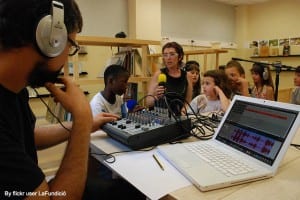 Now, these were all small examples indeed, but they gave me hope. Communication technologies, using portable devices to record witnesses, using computers and the Internet to disseminate opinion to the community, that seemed much closer to what I was getting at. And it might even be an ideal example for our educational needs too, since podcasting allows for set curriculums to come into play. Schools could, for example, help the community to reflect upon world news items by comparing them with historical examples. Or, local economic development projects could benefit from students in math and science incorporating their knowledge and opinions into their broadcasts. School could, through something like radio, through news and through commentary, become relevant again, become contributive and engaging in a whole new sense of the world. And perhaps, by letting something like that actually happen on its own terms, where students use familiar technologies with less control and more real-world variables, the skills we teach our kids could truly prepare them for the unpredictable future they will face.
Now, these were all small examples indeed, but they gave me hope. Communication technologies, using portable devices to record witnesses, using computers and the Internet to disseminate opinion to the community, that seemed much closer to what I was getting at. And it might even be an ideal example for our educational needs too, since podcasting allows for set curriculums to come into play. Schools could, for example, help the community to reflect upon world news items by comparing them with historical examples. Or, local economic development projects could benefit from students in math and science incorporating their knowledge and opinions into their broadcasts. School could, through something like radio, through news and through commentary, become relevant again, become contributive and engaging in a whole new sense of the world. And perhaps, by letting something like that actually happen on its own terms, where students use familiar technologies with less control and more real-world variables, the skills we teach our kids could truly prepare them for the unpredictable future they will face.

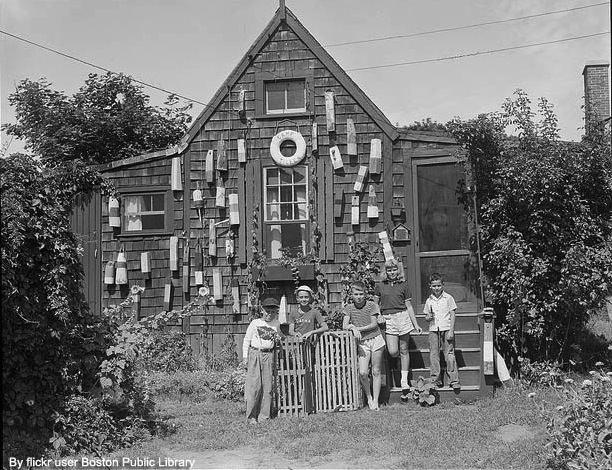
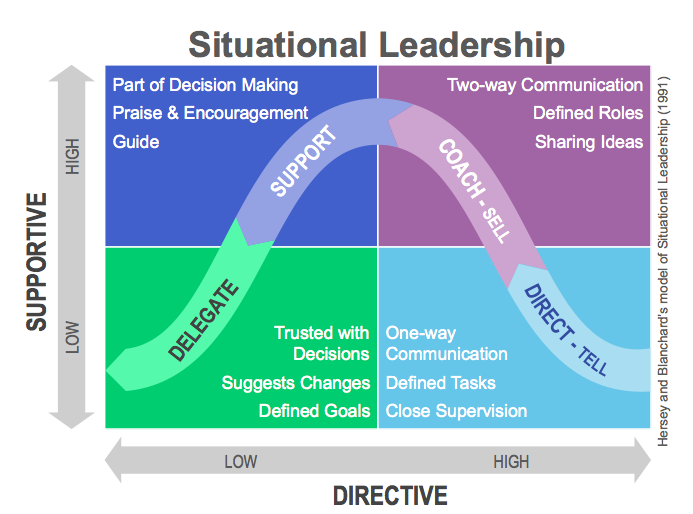
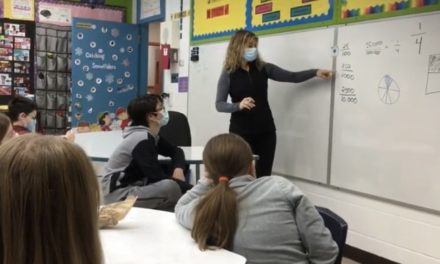

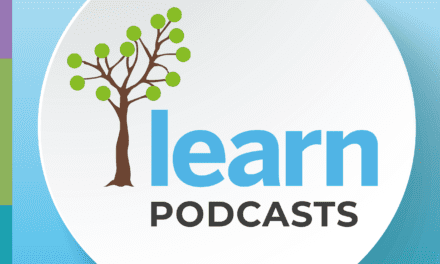
I recently found out about this High School radio initiative – right in our backyard!
http://laurenhillacademy20.wordpress.com/2012/11/13/hello-world/
And you can hear the broadcast on the school web page: http://www.emsb.qc.ca/laurenhill/
I am so with you on this, Paul. Our most recent LEARNing Landscapes journal issue on Informal Learning (www.learninglandscapes.ca) addresses this directly and indirectly in many places. Barbara Rogoff’s commentary comes to mind. In her lifelong work with communities where formal schooling has not been prevalent she shares how even very, very young children learn by contributing to community life through “Intent Community Participation”. We can learn a lot from that. The trick is how to adapt those lessons to our very different world in ways that are more than window dressing.
Mary Stewart